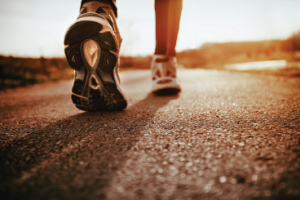
Among people with arthritis in the U.S., 36.2% are active, 22.6% are insufficiently active and 41.2% are inactive.
Likoper / SHUTTERSTOCK.COM
SAN DIEGO—Exercise, within limits imposed by an individual’s circumstances, is an almost universally beneficial medical therapy. In fact, Teresa J. Brady, PhD, senior behavioral scientist with the federal Centers for Disease Control and Prevention’s Arthritis Program, labeled it “medicine” in a session on exercise at the 2017 ACR/ARHP Annual Meeting Nov. 3–8.
Dr. Brady asked whether rheumatologists sufficiently appreciate the benefits of movement or take steps needed to help their patients get up off the couch, citing evidence that only 61% of people with arthritis say their providers have talked to them about exercise. A number of definitions and guidelines for activity exist, she said. Rheumatologists should become familiar with the guidelines and learn the evidence indicating what motivates patients with, for example, arthritis.
In 2008, the U.S. Department of Health and Human Services released physical activity guidelines for all adults, recommending at least 150 minutes per week of moderate-intensity aerobic activity or 75 minutes of vigorous aerobic activity, plus muscle strengthening of seven major muscle groups at least twice a week.1
A recent study of leisure time physical activity from the National Health Interview Survey data set found that among people with arthritis in the U.S., 36.2% are active, vs. 22.6% who are insufficiently active and 41.2% who are inactive. Only 13.7% met both the aerobic and strengthening standards. But rates of meeting the recommendations are up from 2008.2
How do we activate the inactive? It starts with learning from people with arthritis about what they fear and what they understand about the importance of mobility, Dr. Brady said. “They prefer the term ‘physical activity’ to ‘exercise,’ which sounds boring and like a chore.” Based on results from qualitative focus groups, they prefer self-directed physical activity that works for the individual and is convenient to their schedule. They also prefer specific instructions on physical activity.
Common barriers to physical activity include lack of time, competing priorities, fatigue, lack of enjoyment of the exercise and variable definitions of what is meant by physical activity. Arthritis-specific barriers include pain, fear of making the arthritis worse, uncertainty about how much is safe to do and lack of access to arthritis-specific programs.3
Overcoming Sedentary Behavior

Dr. Brady
Dr. Brady discussed how to get the biggest bang for the buck in promoting a healthier, active lifestyle for rheumatology patients. Some physical activity is better than none, even if it doesn’t meet the HHS standards. Even 45 minutes per week can improve or sustain physical function in RA patients, Dunlop et al found.4 Someone can meet the government guidelines, but if they spend the rest of the day sitting, it still has negative consequences for a number of medical conditions, including cardiovascular disease and diabetes.5
She distinguished between sedentary people, who aren’t meeting the activity guidelines, and sedentary behavior—which includes television watching, computer use, reading, driving and other time spent in a sitting or reclining posture. “Less sedentary behavior, by contrast, is associated with better physical function, less future decline in function and lower risk of physical frailty,” she said.6
How can physicians integrate exercise promotion into common medical office interactions? Start with a brief assessment of physical activity on every visit, Dr. Brady said. She outlined a model of behavioral change, based on counseling for weight loss, using a “5A” sequence of supportive behaviors: assess, advise, agree, assist and arrange. She also recommended motivational interviewing, a patient-centered yet directed counseling approach designed to promote behavior change through development of a personal action plan.
Ask patients if they would like to make a plan to do something for their health in the next week and whether they would like to get a check-in from the doctor, she said. “Stop wrestling with your patients and start dancing with them.”
Doctors ought to go rollerblading with their patients—if not literally, then metaphorically, partnering with the patient and leading by example, added Alex M. McDonald, MD, CAQSM, a former professional triathlete and current sports medicine doctor for the Kaiser Permanente HMO in Southern California. In the same session on exercise, Dr. McDonald said his athletic experience has given him a valuable perspective on the importance of exercise. He cited the Exercise Is Medicine (EIM) global health initiative of the American College of Sports Medicine, which encourages primary care physicians to include physical activity in their treatment plans and refer patients to EIM-credentialed exercise professionals.
“Patients come to us afraid to exercise. One patient recently told me he was afraid to move. I gave him permission,” Dr. McDonald said. Physicians during the office visit can ask about the patient’s level of physical activity—its frequency and length of time—make an individualized prescription for more physical activity, and refer to a fitness professional or other resource in the community.
Physicians are challenged to acknowledge the pain their patients experience, with the goal of getting them to move, he said. There may be initial exacerbation of the pain, and yoga or stretching may work better for some patients with RA.
Larry Beresford is a freelance medical journalist in Oakland, Calif.
Exercise Rules of Thumb
Dr. McDonald says:
- Start low and go slow;
- Establish a routine;
- Find the right time and place for exercise; and
- Make it enjoyable.
References
- Office of Disease Prevention and Health Promotion. 2008 Physical Activity Guidelines for Americans; 2008.
- Murphy LB, Hootman JM, Boring MA, et al. Leisure time physical activity among U.S. adults with arthritis, 2008–2015. Am J Prev Med. 2017 Sep;53(3):345–354.
- Wilcox S, Der Ananian C, Abbott J, et al. Perceived exercise barriers, enablers, and benefits among exercising and nonexercising adults with arthritis: Results from a qualitative study. Arthritis Rheum. 2006 Aug 15;55(4):616–627.
- Dunlop DD, Song J, Lee J, et al. Physical activity minimum threshold predicting improved function in adults with lower-extremity symptoms. Arthritis Care Res (Hoboken). 2017 Apr;69(4):475–483.
- Young DR, Hivert MF, Alhassan S, et al. Sedentary behavior and cardiovascular morbidity and mortality: A science advisory from the American Heart Association. Circulation. 2016 Sep 27;134(13):e262–e279.
- Song J, Lindquist LA, Change RW, et al. Sedentary behavior as a risk factor for physical frailty independent of moderate activity: Results from the Osteoarthritis Initiative. Am J Public Health. 2015 Jul;105(7):1439–1445.

